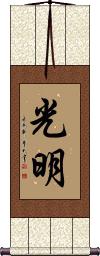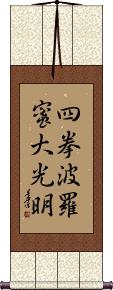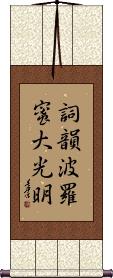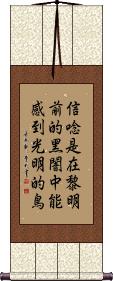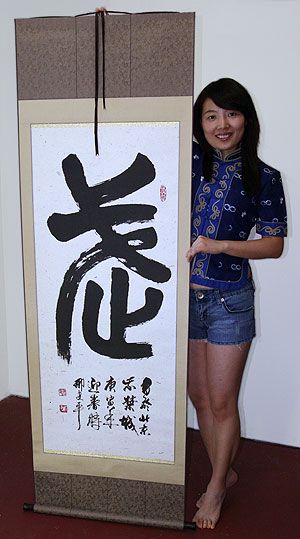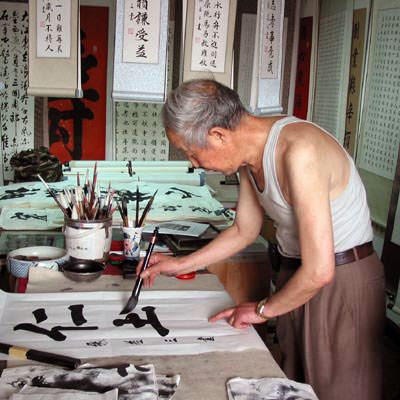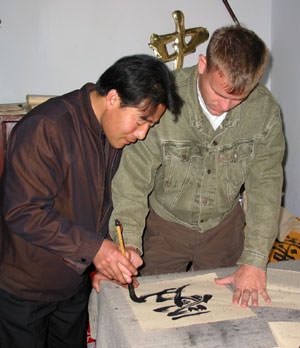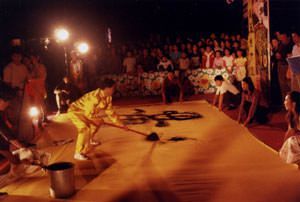Many custom options...
And formats...

光明 in Chinese / Japanese...
Buy an 光明 calligraphy wall scroll here!
Personalize your custom “光明” project by clicking the button next to your favorite “光明” title below...
Light / Bright and Promising Future
光明 is a nice way to say “light” in Chinese and old Korean Hanja.
This is because the word also suggests a bright future or refers to someone who is very promising (great future potential).
The first character means light or bright.
The second character means bright and clear (in this context).
This word appears in most Japanese dictionaries, but it is not the most common Japanese Kanji word for light (more commonly used for the name Mitsuharu).
In old Korean Hanja, this can also mean brightness or brilliance.
In the context of Buddhism, this means “Light emanating from a Buddha or Bodhisattva, symbolizing their wisdom and compassion.”
Reiki - Master Symbol
大光明 is the master symbol “Daikomyo” or “Dai Ko Myo,” which is usually associated with the healing practice of Reiki.
This title can be translated as “Great Bright Light.” This symbol, as used in Reiki, alludes to “Enlightened Nature” or the radiance of a purified soul or deity.
Pronunciations in Chinese and Korean are included above but this title has no meaning except when used by a Reiki practitioner. In fact, this title is not that well known by those outside the Reiki community in Japan.
In Chinese, this would be interpreted as “Great Bright Future” (the second two characters alone create a word that means “bright future” in Chinese).
Shiken Haramitsu Daikomyo
四拳波羅蜜大光明 is “shiken haramitsu daikōmyō,” a famous Japanese Buddhist mantra.
四拳 = shi-ken = four fists (many translate this as “four hearts”).
波羅蜜 = ha-ra-mitsu = A loanword representing pāramitā, or entrance into Nirvana. Awkwardly, it also means jackfruit.
大光明 = dai-kou-myo = big/great light bright (great bright light).
Shiken represents four hearts:
1. The Merciful Heart - Love and caring for all living things.
2. The Sincere Heart - Pursues righteousness, or the right path - sincerely trying to do what is right.
3. The Attuned Heart - Knows that nature and fate have their ways, and thus stay in tune with the universe.
4. The Dedicated Heart - Steadfast on the chosen path to the end.
Shikin Haramitsu Daikomyo
詞韻波羅蜜大光明 are the Japanese Kanji characters that romanize as “Shikin Haramitsu Daikōmyō.”
This is a complicated proverb. I'm actually going to forgo writing any translation information here. You can figure it out via Google search and at sites like Paramita and the Perfection of Wisdom or
Fecastel.Wordpress.com::Shikin Haramitsu Daikōmyō
Faith is the bird that feels the light when the dawn is still dark
信唸是在黎明前的黑闇中能感到光明的鳥 is a philosophical poem/quote from Indian Poet and Philosopher, Rabindranath Tagore.
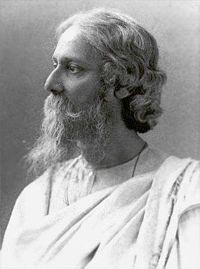
Rabindranath Tagore, 1915
This quote is not sourced, and therefore several variations exist in English. Some suggest the original was in the Bengali language.
This, of course, is the Chinese translation that has the meaning of, “Faith is the bird that feels the light and sings when the dawn is still dark.”
More about Rabindranath Tagore
Not the results for 光明 that you were looking for?
Below are some entries from our dictionary that may match your 光明 search...
| Characters If shown, 2nd row is Simp. Chinese |
Pronunciation Romanization |
Simple Dictionary Definition |
光明 see styles |
guāng míng guang1 ming2 kuang ming kanmyon クァンミョン |
More info & calligraphy: Light / Bright and Promising Future(1) bright light; (2) hope; bright future; (3) {Buddh} light emanating from a buddha or bodhisattva, symbolizing their wisdom and compassion; (place-name) Gwangmyeong (South Korea) v. last entry. |
大光明 see styles |
dà guāng míng da4 guang1 ming2 ta kuang ming oomiya おおみや |
More info & calligraphy: Reiki - Master Symbol |
世光明 see styles |
shì guāng míng shi4 guang1 ming2 shih kuang ming sekōmyō |
light of the world |
光明台 see styles |
koumyoudai / komyodai こうみょうだい |
(place-name) Kōmyoudai |
光明園 see styles |
koumyouen / komyoen こうみょうえん |
(place-name) Kōmyouen |
光明土 see styles |
guāng míng tǔ guang1 ming2 tu3 kuang ming t`u kuang ming tu kōmyō do |
The glory land, or Paradise of Amitābha. |
光明壇 光明坛 see styles |
guāng míng tán guang1 ming2 tan2 kuang ming t`an kuang ming tan kōmyō dan |
The fire altar. |
光明子 see styles |
koumyoushi / komyoshi こうみょうし |
(female given name) Kōmyoushi |
光明寺 see styles |
guāng míng sì guang1 ming2 si4 kuang ming ssu koumiyouji / komiyoji こうみようじ |
(personal name) Kōmiyouji 光明大師 (or 光明和尚). Guangming si, temple and title of 善導 Shandao, a noted monk of the Tang dynasty under Gaozong. |
光明山 see styles |
guāng míng shān guang1 ming2 shan1 kuang ming shan koumyouzan / komyozan こうみょうざん |
(personal name) Kōmyouzan The shining hill, or monastery, a name for the abode of Guanyin, said to be in India, and called Potala. |
光明峠 see styles |
koumyoutouge / komyotoge こうみょうとうげ |
(place-name) Kōmyoutōge |
光明想 see styles |
guāng míng xiǎng guang1 ming2 xiang3 kuang ming hsiang kōmyō sō |
illuminating conception |
光明星 see styles |
guāng míng xīng guang1 ming2 xing1 kuang ming hsing |
bright star; name of North Korean space satellite |
光明池 see styles |
koumyouike / komyoike こうみょういけ |
(place-name) Kōmyouike |
光明滝 see styles |
koumyounotaki / komyonotaki こうみょうのたき |
(personal name) Kōmyounotaki |
光明王 see styles |
guāng míng wáng guang1 ming2 wang2 kuang ming wang Kōmyō ō |
One of the twenty-five bodhisattvas who, with Amitābha, welcomes to Paradise the dying who call on Buddha. |
光明町 see styles |
koumeichou / komecho こうめいちょう |
(place-name) Kōmeichō |
光明石 see styles |
koumeiseki; koumyouseki / komeseki; komyoseki こうめいせき; こうみょうせき |
kōmeiseki; kōmei stone; slightly radioactive stone used in onsens, traditional medicine, etc. |
光明節 光明节 see styles |
guāng míng jié guang1 ming2 jie2 kuang ming chieh |
Hanukkah (Chanukah), 8 day Jewish holiday starting on the 25th day of Kislev (can occur from late Nov up to late Dec on Gregorian calendar); also called 哈努卡節|哈努卡节 and simply 哈努卡 |
光明經 光明经 see styles |
guāng míng jīng guang1 ming2 jing1 kuang ming ching Kōmyō kyō |
Suvarṇa-prabhāsa-sūtra |
光明藏 see styles |
guāng míng zàng guang1 ming2 zang4 kuang ming tsang kōmyō zō |
storehouse of brilliance |
光明谷 see styles |
koumyoutani / komyotani こうみょうたに |
(place-name) Kōmyoutani |
光明院 see styles |
komeiin / komen こめいいん |
(surname) Komeiin |
寶光明 宝光明 see styles |
bǎo guāng míng bao3 guang1 ming2 pao kuang ming hō kōmyō |
radiance of a jewel |
後光明 see styles |
gokoumyou / gokomyo ごこうみょう |
(surname, given name) Gokoumyou |
心光明 see styles |
xīn guāng míng xin1 guang1 ming2 hsin kuang ming shin kōmyō |
mental light |
放光明 see styles |
fàng guāng míng fang4 guang1 ming2 fang kuang ming hō kōmyō |
to shine |
智光明 see styles |
zhì guāng míng zhi4 guang1 ming2 chih kuang ming chi kōmyō |
wisdom-illumination |
法光明 see styles |
fǎ guāng míng fa3 guang1 ming2 fa kuang ming hō kōmyō |
illumination of the teaching |
淨光明 see styles |
jìng guāng míng jing4 guang1 ming2 ching kuang ming jōkōmyō |
vimala-prabhāsa |
Click here for more 光明 results from our dictionary
The following table may be helpful for those studying Chinese or Japanese...
| Title | Characters | Romaji (Romanized Japanese) | Various forms of Romanized Chinese | |
| Light Bright and Promising Future | 光明 | kou mei / mitsu haru koumei / mitsuharu ko mei / mitsu haru | guāng míng guang1 ming2 guang ming guangming | kuang ming kuangming |
| Reiki - Master Symbol | 大光明 | dai kou myou daikoumyou dai ko myo | dà guāng míng da4 guang1 ming2 da guang ming daguangming | ta kuang ming takuangming |
| Shiken Haramitsu Daikomyo | 四拳波羅蜜大光明 | shi ken ha ra mitsu dai kou myou shi ken ha ra mitsu dai ko myo | ||
| Shikin Haramitsu Daikomyo | 詞韻波羅蜜大光明 词韵波罗蜜大光明 | shi kin ha ra mitsu dai kou myo shikinharamitsudaikoumyo shi kin ha ra mitsu dai ko myo | ||
| Faith is the bird that feels the light when the dawn is still dark | 信唸是在黎明前的黑闇中能感到光明的鳥 信念是在黎明前的黑暗中能感到光明的鸟 | xìn niǎn shì zài lí míng qián de hēi àn zhōng néng gǎn dào guāng míng de niǎo xin4 nian3 shi4 zai4 li2 ming2 qian2 de hei1 an4 zhong1 neng2 gan3 dao4 guang1 ming2 de niao3 xin nian shi zai li ming qian de hei an zhong neng gan dao guang ming de niao | hsin nien shih tsai li ming ch`ien te hei an chung neng kan tao kuang ming te niao hsin nien shih tsai li ming chien te hei an chung neng kan tao kuang ming te niao |
|
| In some entries above you will see that characters have different versions above and below a line. In these cases, the characters above the line are Traditional Chinese, while the ones below are Simplified Chinese. | ||||
Successful Chinese Character and Japanese Kanji calligraphy searches within the last few hours...
